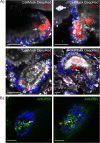Authentic Modeling of Human Respiratory Virus Infection in Human Pluripotent Stem Cell-Derived Lung Organoids
- PMID: 31064833
- PMCID: PMC6509192
- DOI: 10.1128/mBio.00723-19
Authentic Modeling of Human Respiratory Virus Infection in Human Pluripotent Stem Cell-Derived Lung Organoids
Abstract
Infectious viruses so precisely fit their hosts that the study of natural viral infection depends on host-specific mechanisms that affect viral infection. For human parainfluenza virus 3, a prevalent cause of lower respiratory tract disease in infants, circulating human viruses are genetically different from viruses grown in standard laboratory conditions; the surface glycoproteins that mediate host cell entry on circulating viruses are suited to the environment of the human lung and differ from those of viruses grown in cultured cells. Polarized human airway epithelium cultures have been used to represent the large, proximal airways of mature adult airways. Here we modeled respiratory virus infections that occur in children or infect the distal lung using lung organoids that represent the entire developing infant lung. These 3D lung organoids derived from human pluripotent stem cells contain mesoderm and pulmonary endoderm and develop into branching airway and alveolar structures. Whole-genome sequencing analysis of parainfluenza viruses replicating in the organoids showed maintenance of nucleotide identity, suggesting that no selective pressure is exerted on the virus in this tissue. Infection with parainfluenza virus led to viral shedding without morphological changes, while respiratory syncytial virus infection induced detachment and shedding of infected cells into the lung organoid lumens, reminiscent of parainfluenza and respiratory syncytial virus in human infant lungs. Measles virus infection, in contrast, induced syncytium formation. These human stem cell-derived lung organoids may serve as an authentic model for respiratory viral pathogenesis in the developing or infant lung, recapitulating respiratory viral infection in the host.IMPORTANCE Respiratory viruses are among the first pathogens encountered by young children, and the significant impact of these viral infections on the developing lung is poorly understood. Circulating viruses are suited to the environment of the human lung and are different from those of viruses grown in cultured cells. We modeled respiratory virus infections that occur in children or infect the distal lung using lung organoids that represent the entire developing infant lung. These 3D lung organoids, derived from human pluripotent stem cells, develop into branching airway and alveolar structures and provide a tissue environment that maintains the authentic viral genome. The lung organoids can be genetically engineered prior to differentiation, thereby generating tissues bearing or lacking specific features that may be relevant to viral infection, a feature that may have utility for the study of host-pathogen interaction for a range of lung pathogens.
Keywords: lung organoids; parainfluenza virus; respiratory viruses; tissue infection model.
Copyright © 2019 Porotto et al.
Figures






Similar articles
-
A three-dimensional model of human lung development and disease from pluripotent stem cells.Nat Cell Biol. 2017 May;19(5):542-549. doi: 10.1038/ncb3510. Epub 2017 Apr 24. Nat Cell Biol. 2017. PMID: 28436965 Free PMC article.
-
Features of Circulating Parainfluenza Virus Required for Growth in Human Airway.mBio. 2016 Mar 15;7(2):e00235. doi: 10.1128/mBio.00235-16. mBio. 2016. PMID: 26980833 Free PMC article.
-
The Human Nose Organoid Respiratory Virus Model: an Ex Vivo Human Challenge Model To Study Respiratory Syncytial Virus (RSV) and Severe Acute Respiratory Syndrome Coronavirus 2 (SARS-CoV-2) Pathogenesis and Evaluate Therapeutics.mBio. 2021 Feb 22;13(1):e0351121. doi: 10.1128/mbio.03511-21. Epub 2022 Feb 15. mBio. 2021. PMID: 35164569 Free PMC article.
-
Modeling Host-Virus Interactions in Viral Infectious Diseases Using Stem-Cell-Derived Systems and CRISPR/Cas9 Technology.Viruses. 2019 Jan 30;11(2):124. doi: 10.3390/v11020124. Viruses. 2019. PMID: 30704043 Free PMC article. Review.
-
[State-of-the-art in respiratory disease research using respiratory organoids].Nihon Yakurigaku Zasshi. 2023;158(1):71-76. doi: 10.1254/fpj.22086. Nihon Yakurigaku Zasshi. 2023. PMID: 36596495 Review. Japanese.
Cited by
-
Harnessing organs-on-a-chip to model tissue regeneration.Cell Stem Cell. 2021 Jun 3;28(6):993-1015. doi: 10.1016/j.stem.2021.05.008. Cell Stem Cell. 2021. PMID: 34087161 Free PMC article. Review.
-
Human pluripotent stem cells for the modelling and treatment of respiratory diseases.Eur Respir Rev. 2021 Aug 3;30(161):210042. doi: 10.1183/16000617.0042-2021. Print 2021 Sep 30. Eur Respir Rev. 2021. PMID: 34348980 Free PMC article. Review.
-
Human parainfluenza virus evolution during lung infection of immunocompromised individuals promotes viral persistence.J Clin Invest. 2021 Dec 1;131(23):e150506. doi: 10.1172/JCI150506. J Clin Invest. 2021. PMID: 34609969 Free PMC article.
-
Microfluidic Organoids-on-a-Chip: Quantum Leap in Cancer Research.Cancers (Basel). 2021 Feb 10;13(4):737. doi: 10.3390/cancers13040737. Cancers (Basel). 2021. PMID: 33578886 Free PMC article. Review.
-
3D tissue-engineered lung models to study immune responses following viral infections of the small airways.Stem Cell Res Ther. 2022 Sep 7;13(1):464. doi: 10.1186/s13287-022-03134-1. Stem Cell Res Ther. 2022. PMID: 36071442 Free PMC article. Review.
References
Publication types
MeSH terms
Grants and funding
LinkOut - more resources
Full Text Sources

